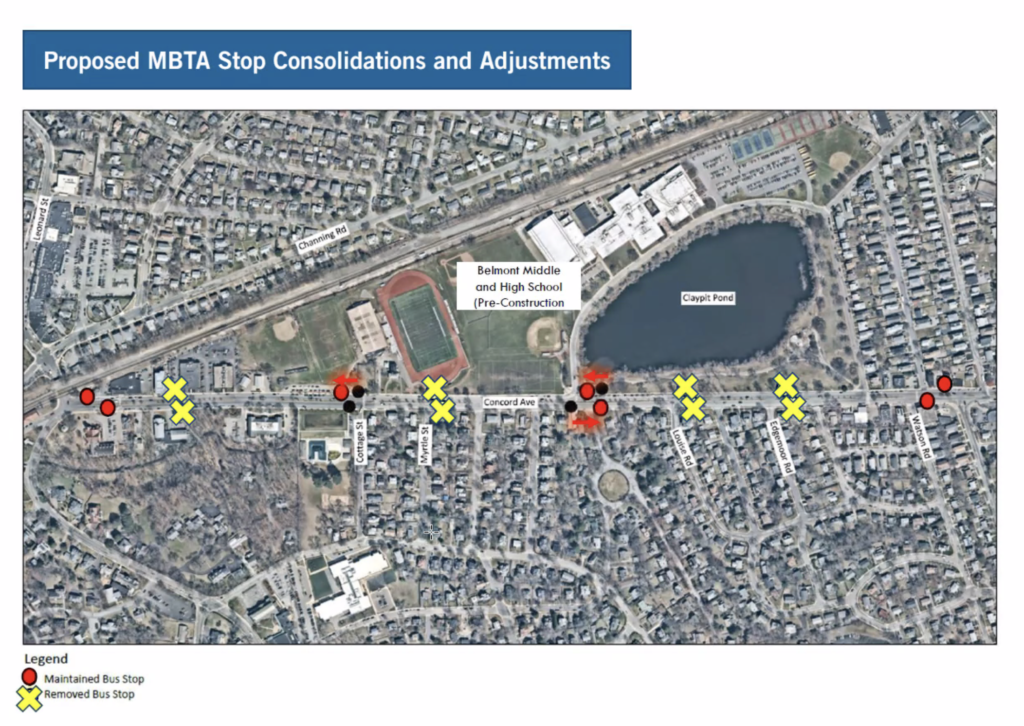Photo: A protected bike lane in Portland, Oregon.
Both sides of Concord Avenue will soon have protected bike lanes from Belmont Center to Blanchard Road on the Cambridge city line as part of a new road “striping” design to make the main thoroughfare safer by the time the high school section of the new Belmont Middle and High School opens in mid-September.
With a deadline breathing down the town’s – aka Town Engineer Glenn Clancy – neck to complete the job on-time, the Transportation Advisory Committee voted 7-0 on Thursday, May 13 to approve a revised blueprint delineating the street presented by consultants that will transform travel and parking on the street.
TAC’s recommendation now heads for a final OK by the Select Board which will take up the committee’s endorsement at its Monday, May 24, meeting.
The mark up of the roadway will begin in August to be completed by the opening of school in mid-September.
Bill Schwartz, a principal at the Boston office of Nelson/Nygaard, said the latest plan for Concord Avenue was created with the new Middle and High School in mind in an effort “to see more students walking and … more students biking to campus” while creating a plan that will calm the traffic rising the corridor in cars.
The most significant change to the current setup will be the parking-protected bike lanes located from the curb and separated from the roadway by a buffer zone and parking spaces. In many places, plastic bollards – known as flex poles – located in the buffer zone will delineate the separation between parking and the new path.
“This was a commitment made during the high school planning project stage,” said Schwartz of the bike lane.
The current practice of parking along the curb and the bike lane next to a busy traffic lane “discourages less experienced cyclists from driving” on the street and ends the “big hazard of getting ‘doored’ by someone opening their door from a parked car,” said Schwartz.
Schwartz said the bollards will be needed for a specific time until drivers become familiar with the new arrangement. He noted the bollards can be removed during the winter to allow snow plowing. Clancy said he wants to be “very judicious” in the number of flex poles used.
There are two designated drop-off/pick-up locations at the new school; on the south side just past Oak Street and directly opposite Orchard Street on the north side. Each will have four spots.
The plan calls for the reduction and relocation of some MBTA bus stops, spaced approximately 1,300 feet as opposed to the current 400 to 600 feet “so that the buses are not stopping so often” which makes for “pretty frustrating” travel, said Schwartz. The revisions plan will reduce the number of stops to four along the stretch of street.

The number of parking spaces along the road has been increased from the first plan after comments from businesses located inbound from the Cambridge line who felt too many spaces were being removed affecting the their business. The consultants moved a bus stop on the east side of Trowbridge Road and used parking zones rather than individual marked spaces.
In the most congested residential area from Blanchard to Underwood – the north side of the street from the Cambridge line to the street leading to the new school – the latest version picked up more parking spaces, yet the number of parking spaces have dropped from 31 to 23, a loss of nine total. And that’s the rub for residents along the street who live in mostly two and three-family houses.
Jeff Held of Concord Avenue said the overall reduction of parking will hit home for those who live between Blanchard and Hamilton roads – which will see parking spaces fall from 11 to 7 – as he sees residents competing with construction workers and high school students looking for parking for the next two years as the middle school segment of the project is under construction. Held said the solution is for the protected bike lane to begin at Underwood as the current path “is very generous” and “co-exists really nicely” with the roadway and vehicles.
But Schwartz was opposed to having a “big stretch of the project unprotected” which he believes defeats the point of having a protected bike lane. TAC Chair Dana Miller quickly put a halt to the residents suggestion, instead receiving a commitment from the town and Belmont Police to come up with a parking control plan to prevent those spaces being used all day by students or non-residents while calling Nelson/Nygaard to give more thought on “how we can approach [parking] most constructively.”
Update: A sentence was added after the article was initially published online to clarify that the TAC’s vote was a recommendation that needs Select Board approval before the striping expense can be placed in the fiscal year 2022 Pavement Management contact.








Has this been approved by the Belmont Board of Selectmen?
It goes before the Select Board on Monday, May 24.